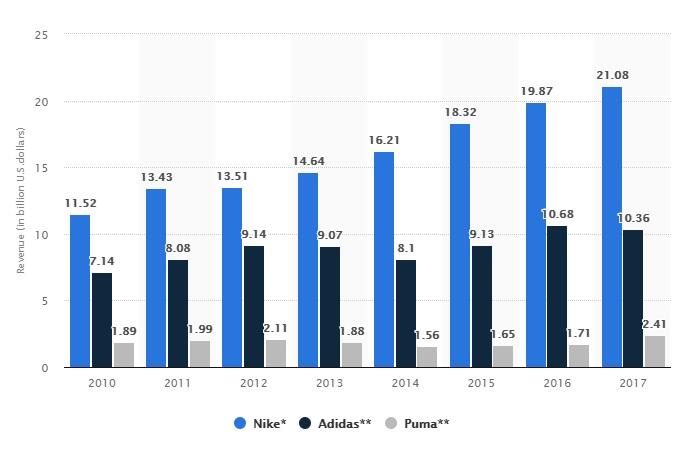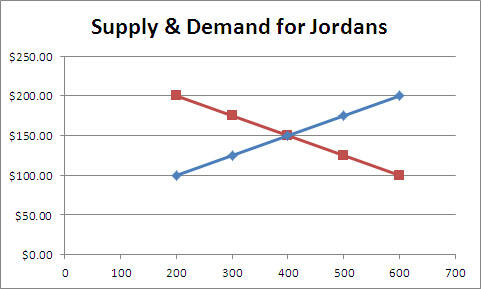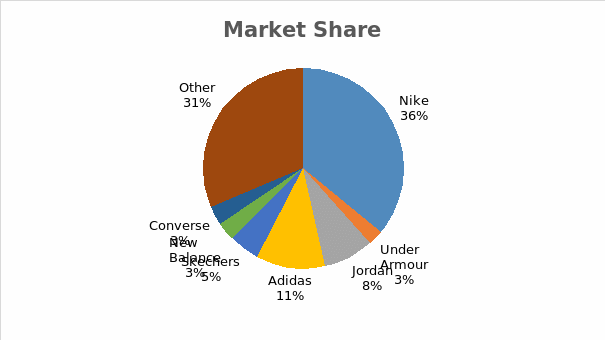The modern business environment provides multiple opportunities for various companies to evolve and generate a stable income. The constantly increasing and diversified needs of customers result in the emergence of the necessity to create particular products to satisfy this demand. This tendency can be used by many corporations to build the basis for further growth and becoming leaders.
However, the existence of all these factors also means a high level of rivalry as many actors want to enter the market and achieve success. Under these conditions, macroeconomic analysis becomes a potent tool that can be used to investigate the current situation, forces impacting a particular sphere, and create the most effective strategy that will result in the improved functioning of the company, acquisition of competitive advantage, and its stable growth.
The given work is a research paper devoted to the investigation of the firm Nike as one of the leaders in its sphere. The central purpose is the detailed and in-depth investigation of the peculiarities of the brand’s functioning regarding the current market’s features, the progress of the closest rivals, and possibilities for further growth. To conduct the study, Nike’s impact on the industry, pricing strategy, costs of production, and position in the selected segment are assessed.
The data collected due to this in-depth analysis is used for the discussion and creation of recommendations for the corporation’s further development and growth. All findings related to the macroeconomic showings and peculiarities are incorporated in the conclusion that outlines the most important elements of Nike’s functioning, opportunities for its further development, and effectiveness of currently used strategies. Altogether, the report contributes to the enhanced understanding of the forces affecting companies and approaches that remain effective.
Today, Nike is the world’s largest brand focused on the manufacturing and distribution of athletic footwear, apparel, accessories, and services. It was founded in 1964 as the firm Blue Ribbon Sports by Bill Bowerman and Phil Knight (“Nike’s heritage,” n.d.).
Later, in 1971 it was officially called Nike from the Ancient Greek Goddess of victory (“Nike’s heritage,” n.d.). Due to the firm’s successful development, it managed to diversify and expand its business and buy shoe companies such as Cole Haan, Converse Inc., Canstar Sports, Umbro (NIKE, Inc., 2018b). The successful advertising campaign along with the potent marketing strategy preconditioned the blistering rise of the brand and it is becoming one of the leaders of the industry. At the moment, the company holds a market share of about 37% and is well-known in all parts of the world (NIKE, Inc., 2018b).
It sells high-quality and premium clothes, footwear, and sports accessories for customers and famous athletes. The company is also an official sponsor of various events and clubs which also helps to improve its image and popularize its products among customers.
Supply and Demand Conditions
Analyzing the company’s functioning, it is critical to evaluate trends in demand for its central products over time. Being a leading manufacturer of sports footwear, Nike critically depends on the current level of customer interest in this product. It should be noted that there is a constantly growing attention to high-quality sports equipment, inventory, and accessories. The gradually increasing level of income among various population groups preconditions the reconsideration of buying behaviors and the emergence of the desire and opportunities to buy outstanding footwear such as produced by Nike. The following graph shows the current trends in the segment:

Figure 1 outlines that in the period from 2010 to 2017 Nike enjoyed the constantly growing level of revenue from the footwear segment. The given fact evidence that customers demonstrate a high interest in central products manufactured by the investigated brand and contribute to its development by preferring to purchase a certain brand.
Another critical part of the brand’s analysis is the correlation between the demand and supply for products essential for the company’s functioning. As it has already been stated, Nike is focused on the production of sports footwear that is appreciated by customers globally. At the moment, Nike faces a problem of overproduction which results from the desire to meet the growing demand and achieve a high level of sales (NIKE, Inc., 2018b).
There is a tendency towards the increase in people’s interest in this sort of products. It means that companies can produce more to ensure that people will be able to enjoy the brand. However, the problem of oversupply emerges as Nike losses its privileged or “cool” status (Archer, 2017). All customers who wanted to buy the shoe did it, and there were still products in shops that could be sold. For this reason, there is a particular divergence between the supply and demand for Nike’s footwear:

Figure 2 shows that at the price of $150 per pair, the needed demand is 400. However, at the moment, the company manufactures larger amounts which result in the absence of equilibrium and decreased interest in its products.
Price Elasticity of Demand for the Product
The next element of the functioning of any corporation is the ability to adapt prices and introduce potent pricing strategies that can help to evolve and cooperate with customers. For this reason, investigation of the price elasticity of demand for the investigated product (footwear) becomes one of the essential parts of the macroanalysis. The given term can be determined as the measure that is used to outline elasticity of the quality demanded of a good to a change in its price (Kotler & Armstrong, 2015).
In such a way, it becomes a potent tool while evaluating the work of any corporation and its ability to adapt to new conditions. Speaking about Nike, its pricing strategy should be considered rather flexible.
The brand produces comparatively expensive shoes that meet the high standards of quality and can be bought by people with an average or high level of income. At the same time, considering the severe rivalry peculiar to the sphere and existence of such brands as Adidas, Reebok, Puma, there is a high risk of substitutes. For this reason, the company should be ready to alter its pricing strategy and approach to ensure that customers will remain attracted by its products and pay for shoes. The given fact evidences the high level of price elasticity which means that the company can adapt its prices to the alterations in the current situation in the market and ensure that the customers will not be attracted by the closest competitors.
Price elasticity is closely connected to the idea of customer responsiveness which should also be analyzed while speaking about the functioning of Nike and macroeconomic factors that impact its development. The term can be defined as accurately providing customers with products they need at the moment contributing to the satisfaction of their needs (Kotler & Armstrong, 2015). It might also mean the introduction of the product that will be demanded in the future more quickly than the closest rivals so individuals will remain attracted by the brand.
As for Nike, it tries to analyze the market comprehensively to acquire an improved understanding of the existing trends and the way they will evolve. It provides them with an opportunity to create sports footwear that will become popular and introduce comparatively high prices for it to generate revenue. Outdated or less popular models become cheaper over time because of the decreased customers’ interest in them.
However, sometimes the corporation fails to adhere to the concept as the supply is too high and products remain unsold (as in Jordan’s sneakers case). Nevertheless, in the majority of situations, the potent and appropriate market analysis provides the brand with the opportunity to reach high price elasticity levels and act in a consumer responsively manner which contributes to the increased sales. In general, one can understand that both these concepts directly impact pricing decisions as they create the basis for the introduction of a certain price for products and their better sales.
In its turn, correct decisions in the given sphere precondition revenue growth as it helps to preserve the high level of customers’ interest in the brand, create the image of exclusiveness, and guarantee that all demands existing at the moment will be satisfied, which is critical for the brand’s further evolution. Nike’s effective functioning regarding price elasticity and customer responsiveness create the basis for its further growth and help to minimize risks related to the decreased demand for footwear produced by it.
Costs of Production
Another critical element of the analysis is the cost of production as any company’s functioning depends on the amount of money needed to manufacture a good that will be sold to customers. As for Nike, it faces multiple costs starting from shipping and ending with payment to partners. However, these remain low due to the effective approach that helps to minimize the price of manufacturing. The fact is that instead of having its factories that should be provided with all materials needed to create a pair of sneakers, Nike cooperates with independent contract manufacturers all over the world (“From factory to footwear,” 2018).
Speaking about the footwear division, the share of independent factories responsible for their production is about 96% (“From factory to footwear,” 2018). In such a way, the brand significantly decreases the number of costs and saves about $0,15 per unit which can be considered a great success (NIKE, Inc., 2018a). It helps to acquire a competitive advantage and avoid extra spending.
Nike also cooperates with independent companies to acquire the needed raw materials for shoes. These agents are situated in countries where the products are produced. It helps to minimize the price of one pair by excluding unnecessary actors and limiting the number of vendors that should be paid. Due to this effective strategy, the brand manages to achieve an average price of about $15 for one pair of shoes which is significantly lower than its retailing price (NIKE, Inc., 2018a). This fact evidences the effective strategy used by Nike to deal with all possible costs.
Moreover, using the given approach, the firm manages to significantly reduce labor and raw materials costs. As it has already been stated, there are many partners in various regions such as China, Vietnam, Indonesia. This strategy helps to minimize labor costs as wages in these regions are significantly lower if compare with the USA and other European states (NIKE, Inc., 2018a). In such a way, minimizing the input, the company increases the output and achieves better performance. Furthermore, speaking about costs devoted to raw materials, their price is also lower in these regions. In such a way, the utilized strategy helps the brand to remain competitive and achieve the best possible results via the elimination of extra costs or their effective management.
Market Analysis
Analyzing the footwear market, it should be said that Nike is the current leader that holds its positions and continues to grow. The following situation can be observed:

Figure 3 shows the distribution of market shares in the sphere. As one can see, Nike is far from its closest rival Adidas which also includes the Reebok brand. Jordan is also owned by Nike, which means that the position is even stronger (NIKE, Inc., 2018a). The given tendency has already been topical for the market for the last five years as the brand demonstrates stability and ability to compete with the closest rivals by utilizing effective strategies.
The numbers also show that there is a comparatively small risk of the emergence of new competitors. The high level of rivalry along with the potent position of leaders serves as the barrier for new actors as they become unable to enter the market and generate revenues in comparatively short terms. For this reason, Nike designs its strategies mainly taking into account the current state of its closest competitors not fearing the emergence of new potent brands. It can also serve as the guaranty of the company’s further stable development, as no factors are evidencing the end of its dominance or opportunities for a new entry.
Speaking about the market structure of Nike, it should be mentioned that the company’s products differ from their competitors’ ones. It means that possessing all qualities needed for perfect competition, the brand can directly affect the market and become a monopolist which sets its own rules and regulating the emergence of various trends (Kotler & Armstrong, 2015). In such a way, it can be considered an example of monopolistic competition as it is characterized by the high level of product differentiation, and the dominance of a particular brand which can be evidenced by shares Nike has at the moment. In such a way, the footwear market remains highly dependent on the brand’s strategic decisions.
Recommendation
Considering the provided information, several recommendations can be offered for the firm to manage its future production and guarantee further growth. First, it should achieve the balance between supply and demand as overproduction decreases the level of customers’ interest in the brand. In such a way, the point of equilibrium can be achieved by the detailed investigation of the market and moods or buying behaviors among customers. The dominant position of Nike can be used to ensure that the offered reconsideration of the approach will not affect further evolution and result in failure.
Moreover, even though the current pricing strategy remains flexible enough, there is still the need for effective management to ensure that limited versions of footwear will cost higher, while products that are overproduced will have lower prices to guarantee that they will be bought by customers. It will help to attract a new target audience, increase revenue, and achieve better showings related to customer responsiveness and flexibility.
Finally, being a monopolist in the market, Nike should monitor its development to admit current brands and use its powerful position to preserve the leading position and avoid the emergence of new actors who can attract its clients. That is why it is critical to adhere to the current strategy that remains effective enough and provide individuals with high-quality products that differ from the same offered by the closest competitors.
Conclusion
Altogether, Nike remains one of the leaders in the footwear market. The history of the brand can be considered the history of success as it managed to evolve from a small company to a giant corporation that impacts the whole industry and preconditions the emergence of particular brands. One of the fundamentals of this success is an effective strategy and reduction of costs needed to produce products. Cooperation with partners in various regions helps to minimize input and maximize output via the elimination of optional vendors. At the same time, it provides an opportunity to achieve better flexibility while speaking about pricing strategy and meet customers’ demand by offering products they might need. To preserve its leading positions, Nike should solve the problem of overproduction and ensure that demand and supply are balanced.
References
Archer, S. (2017). There’s a simple formula that explains how Nike lost its sneaker mojo (NKE). Markets Insider. Web.
Bain, M. (2017). Adidas just achieved the unthinkable by overtaking Nike Jordans in US sales. Quartz. Web.
From factory to footwear. (2018). Web.
Kotler, P., & Armstrong, G. (2015). Principles of marketing (16th ed.). New York, NY: Pearson.
NIKE, Inc. (2018a). Annual report. Form 10-K. Web.
NIKE, Inc. (2018b). To our shareholders. Web.
Nike’s heritage. (n.d.). Web.
Revenue from footwear segment of Nike, Adidas and Puma from 2010 to 2017 (in billion U.S. dollars). (n.d.). Web.